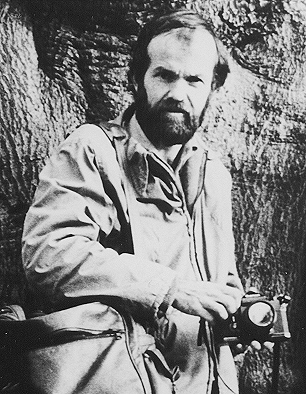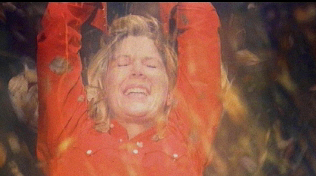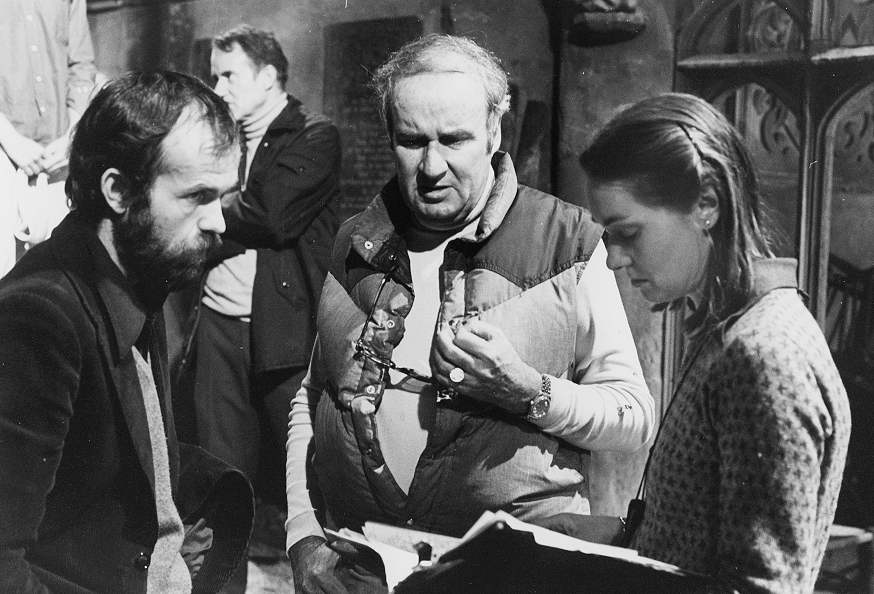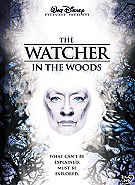Interview with

Photo taken during the
re-shoot circa 1981
Harrison Ellenshaw

Conducted
By Scott Michael Bosco
HE
This is the second film I've done where I kept a journal. The other was CAPTAIN EO (for the Disney theme park.) God I have a lot stuff.
SB
How many different endings were considered when
it was decided to change
WATCHER IN
THE WOODS?
HE
Well the film was released then it was pulled. The story department and various people at
studio all came up with endings. I have
all those endings in a package. They
were all awful and that was part of the problem. They appeared to come up 3 endings that were
submitted to the story department, who in turn came out with their own
versions. So when I was asked to come
aboard I was handed a pile of these endings, roughly a 152.
SB
...all for the second version?!
HE
Yes. I had absolutely
nothing to do with the first version. I
wasn't even at the studio. I was working
on THE EMPIRE STRIKES BACK. So the first
thing I did was look at the film. Then I went through all these endings, which
all wretched.
SB
Did anyone ever go back to the book it was based
on?
HE
There must've been a reason that I didn't go back to the
book. Or I did and just don't remember?
But you're absolutely right. That is
something, I think anybody would do.
SB
As it stands, your ending
is closer to the book on a basic level - different but still closer. After you proposed your ending was it
changed?
HE
It got
modified but basically what we shot was what I wrote.
SB
So the Watcher, as you proposed, was that pillar
of light and not the creature.
BE
It was.
SB
Now that you came up with
a "new" Watcher how were you going to pull it off?
BE
I didn't think that the pillar of light was going to be
terribly difficult to do. In fact I
probably found the other stuff I did more challenging. We did a lot of
different tests . Finally, I came up with the idea of dropping this tar
substance over a form. I've always liked
the impression gravity gives to falling objects when played in reverse. As something falls it escalates then you play
it backwards and it really looks neat.
SB
So that's what we're seeing when the Watcher is
forming?

HE
Yes. As you look at the
image of it forming it's the tar substance falling from a skull but played
backwards. The image of the face, of the
skull, is really subliminal. I wanted to
give an impression without being over barring.
Like an alien, or something scary.
It a traditional kind of image that's suppose to be scary.
SB
It's really a great
effect enhanced with the leaves blowing away from under it as it glides down
the chapel isle.
HE
Those leaves were really a pain in the neck. It's really tough to isolate wind and the
movement of the leaves the way you want it.
SB
How did you finally do it?
HE
Well it was done with fans and with funnels. Sort of leaf blowers. But 1980 there weren't any leaf blowers so we
had to come up with something on our own.
It was very difficult to do. We
even considered matting in the leaves.
SB
I guess the cost ruled that out.
HE
That was a
concern of course.
SB
When the apparition
approaches Jan it covers her, changes color and seems to take on a different
shape. Did you at any time plan for it
to materialize into anything more concrete?
HE
No. It only takes
"a" form but nothing ever too substantial. I wanted it to surround her and then take her
off. It was like putting her under it
arm and off it goes.

SB
In a way ‑ as in the original ending.
HE
In a way, yes. Except
in this ending she was meant to switch places with Karen - except she's saved by Mike. Part of the reason for changing the ending
was to make Mike the hero. In the
original ending there was no hero.

SB
That's what I liked about the original. They all seemed to be at the whim or mercy of
this unknown thing. Which puts the main
characters even with the audience. Each
are trying to guess how to beat the obstacle.
In a sense, it's truer to life and less theatrical.
HE
You're absolutely right that's what life is like. But that's why, I think, people like
movies. The hero is in control. I agree with you one hundred percent, but in
1980 I wouldn't have agreed with you. I
feel movies, especially the endings are a direct reflection of the writer,
director and those in control. This
ending I worked on is a real reflection of me.
I'm not saying that makes it good.
It's just a different way of concluding the story. I hope, in a satisfying way.
SB
So you wanted a more science fiction ending than
a supernatural one?
HE
I wanted a more ambiguous looking Watcher. I didn't want anything that you could reach
out and touch. That was the biggest
problem with the first version, I thought.
It came across too much as a monster.
I thought making it more of a "ghost" film with a Watcher that
was less concrete added to this transition of the girls. Even though that's still science
fiction. And you know, probably what's
so difficult about the film is that it's a mixed genre. It breaks those rules that have been
traditionally set up. That's not a bad
thing but, I think it does make it difficult for the audience. There have been successful films that have
done that, but it just lessens their chances of success.
SB
So you think it tried to be too much?
HE
That's one of the reasons we got rid of the
original opening.
SB
…and Main titles that were shown over a burning
doll?
HE
Yes. As powerful as it was
it really made the Watcher into an evil kind of thing. I mean, if he's struggling to get back to
wherever he came from then why would he be going around frightening little
girls. It brings up feelings towards the
Watcher that is difficult to resolve at the end. In other words, the HUNCHBACK OF NOTRE
DAME doesn't work here because the character of the Watcher is never
developed. I don't know how it is in the
book but is was a path the film went down and had difficulty in transposing.
SB
Well in the book the
Watcher is handled differently because it's a completely different thing. The
same is true with the first version of the film. The Watcher is completely different, not only
in its physical appearance but in character.
HE
With a book there's a whole different set of rules. A lot of books just don't translate into
film. When they do, it's great! You're
right, this aimed to be a film that bit off more than it could. Perhaps it just
needed that one scene that could put the right message across.
SB
It's strange you said
that because I remember talking to Tom. (Tom Leetch Co‑Producer) about a
scene in the book where the Watcher communicates to Jan and her father through
the T.V. It shows them where it came
from, through 3-D images out of a that fly out into the room of its journey to
its home. Images, like in the movie SPHERE
where whole planets fly by the characters.
HE
Oh that sounds great.
SB
I don't know why they didn't use that?
HE
You know why? Because they couldn't do it. At the time it was a small studio, somewhat
behind the times and of course cost was a factor. But you know, that scene would have helped
pay off the ending. Especially mine. Too often in films that deal in big endings
the audience is not given a taste of it earlier on. So it seems to come out of left field and in
spite of itself, does not succeed.
People then say, "Now wait a minute this is outside the rules
you've set up though out the movie."
People are very willing to suspend their disbelief providing that rules
are set down and followed.
SB
Is that one of the
reasons you decided on the Watcher to be a being made of energy? Simplifying its look flows over into its
origins and elevates questions?
HE
Well I'm a great believer that simpler is better. After I went through all the endings I just
sat down and felt we have to get as basic as possible. Otherwise I'd be like everyone else, trying
to come up with a "clever" ending, with a little twist. I did fall into that trap a little bit when I
came up with an epilogue. Fortunately I
saw the error of my ways and didn't use it.
SB
A closing statement of
documentation would now be considered an X FILES way of closing the story. Like the book CARRIE, it was written, through news reports and periodicals.
HE
Well the success of the X‑FILES is that “we” the
audience never knows everything. It’s
the mystery.
SB
But you know where it all
springs from? Bram Stoker. The novel
DRACULA is written in journal format.
Jonathan Harker writes, "We want no proofs; we ask none to believe
us!"
HE
Oh that's interesting.
You know, generally notation or narration doesn't work in film. There are great exceptions. I think most people just feel, "I just
spent my money, now I have to read, to work!
Come on, thrill me, show me!"
That's what influenced me in making the changes I did. That's why I made
Ellie a sort of narrator, for the Watcher to speak through.

SB
True, but it also brought
her back into the story when in the original she was kinda left out. It's a natural for you to make that
discussion since the Watcher uses her earlier in the film, more than once.
HE
Oh absolutely. It also
gave her a reason for being a kinda of wacky little kid from the beginning.
SB
Only now the mother is
thrown out where she was originally in the ending. Then again, the father never really played a
part of any importance.
HE
Well I think at the time the actor (David McCallum) wasn't
available for the re‑shoot. But
you're right he didn't really play an important part.
SB
I think that's because in
the book it centered on the women and the different generations. It's kind of coming of age story for Jan
really. She sees how the disappearance
of Karen has affected different people.
She thinks about Mrs. Alwood, and how she's grown old waiting for her
daughter to return. It makes her
consider her own mother, and the realization of her becoming like Mrs. Alwood,
and in turn seeing herself becoming like her mother. None of that is touched in the film. It concentrated on being only a thriller.
HE
But you see that's typical of a lot of
SB
You also worked on the
alterations made on the rest of the film.
I believe you wanted some previous effects changed too?
HE
Yes. Nothing big. There's a scene where there's a flash of
light from the Watcher that blinds a truck driver. It was too blue so I had it toned down. Also, there was the bleeding hand from the
cracked glass. We lessened the
blood. It was too red.

SB
Would you have expected any less from a director
of Hammer films? (BOTH LAUGH)
HE
But you know,
everything shot for the second version was by a different director.
SB
Really!
HE
Yeah. It was Vince.
I had spoken to John Hough (pronounced Huff) the original director who
was working on another film at the time in

Harrison Ellenshaw (Left), Vincent McEveety
(Center) and confer with the Script
Supervisor (Right).
SB
The fish‑eye lens.
HE
Yes. That's John
Hough. That's why, whenever possible,
Vince tried to choose shots as John would.
One thing about Vince, he's very good at placing a camera to state
geography. You know, where people are in
relation to each other. I think back to
how I would have done it and I see that Vince brought with him experience that
made it work. Different and better than
I would have done it.
SB
Any other
changes?
HE
I know we had some discussions about when the family first
visits the house. Then there were little
things, like when Jan first senses the Watcher.
I think it was an overly dramatic zoom shot that was cut. Her reaction was way too much. Like she saw something horrific. It was too
much for the first reel. I wanted it to
me more subtle. To ease into the
mystery.
SB
Then again, she was
reacting to a film with a different protagonist. The Watcher was totally different. Her reaction was not in tune with your
Watcher.
HE
I suppose so. We also
filmed a different beginning. We went
back to the same woods, the same location in England.

Left – Godfrey Godar,
Director of Photography, Jim Bawden, Camera Operator, Harrison Ellenshaw and
Director Vincent McEveety
SB
Did you have any input with the editing of the
final segment?
HE
Yes. When we finished
shooting Vince went off to do another show and Tom (Leetch) and I worked with
the original editor
SB
Were there any mattes done for the second
version?
HE
There was probably the eclipse and I think the matte
department put together some of the Watcher elements. But I'm not too sure. David Mattingly was head of the matte
department then.
SB
What about the chapel set for the final scene?
HE
Everything was reconstructed with the same Production
Designer, Elliot Scott. A wonderful man,
an old time English production designer.
They had saved all the parts of the set. Everything was reconstructed,
and then a wall, and a doorway was shipped back to

SB
Truthfully all the new footage was matched in
perfectly.
HE
Oh yeah. They
did a great job. It was great. Very gratifying.
Copyright ©
Special thanks to Harrison Ellenshaw for his generous support
and photographs.




Read the DVD reviews for both the ANCHOR BAY & DISNEY releases

